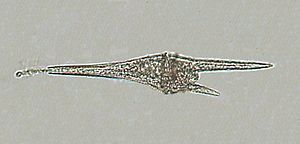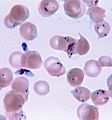Alveolate facts for kids
Quick facts for kids AlveolataTemporal range: Ediacaran - Recent
|
|
|---|---|
 |
|
| Ceratium furca | |
| Scientific classification | |
| Domain: | |
| Kingdom: | |
| Superphylum: |
Alveolata
|
| Phyla | |
|
Ciliophora |
|
Alveolata are a fascinating group of tiny living things called protists. They are so small you need a microscope to see them! Scientists group them together because they all share a special feature: tiny sacs called "alveoli" just under their outer skin. Think of these sacs like little air pockets. This big group, Alveolata, includes many different types of protists, some of which are very common in water, while others can even live inside other animals.
What are Alveolata?
Alveolata is a large group of protists. Protists are like the "catch-all" group for living things that aren't animals, plants, or fungi. What makes Alveolata special is that they all have tiny, flattened sacs called alveoli right under their cell membrane. These sacs are like small, empty pouches. Scientists believe these sacs help them in different ways, like keeping their shape or helping them move.
This supergroup includes at least four main types, called phyla. Each phylum contains many different species, all with their own unique ways of living.
Main Groups of Alveolata
Here are the four main groups, or phyla, that make up the Alveolata:
- Ciliates: These are very common protozoa (single-celled organisms). They are known for having many short, hair-like structures called cilia arranged in rows. Cilia help them move around in water and also sweep food into their mouths. A famous example is the Paramecium, which looks like a slipper. Ciliates are found almost everywhere there is water, from ponds to oceans.
- Chromerida: This is a newer group of marine (ocean-dwelling) protozoa. What's special about them is that they can perform photosynthesis. This means they can make their own food using sunlight, just like plants do! They are important parts of the ocean's tiny ecosystem.
- Apicomplexa: These are a group of parasitic protozoa. This means they live inside other living things, like animals, and get their food from them. Most Apicomplexa do not have structures for moving around, except for their gametes (reproductive cells). Some well-known Apicomplexa can cause serious diseases, such as Plasmodium falciparum, which causes malaria in humans.
- Dinoflagellates: These are mostly marine flagellates. Flagellates are organisms that have one or more whip-like tails called flagella that help them move. Many dinoflagellates have chloroplasts, which means they can also do photosynthesis. They are a very important part of the plankton in the ocean. Some dinoflagellates can even glow in the dark, creating beautiful "sea sparkle" effects! Others can produce toxins that cause "red tides," which can be harmful to marine life and humans.
Images for kids
-
Vorticella (Ciliophora) (left)
-
Plasmodium falciparum (Apicomplexa) in blood
-
Eimeria maxima (Apicomplexa)
-
Dinophysis acuminata (Dinoflagellata)
See also
 In Spanish: Alveolata para niños
In Spanish: Alveolata para niños






